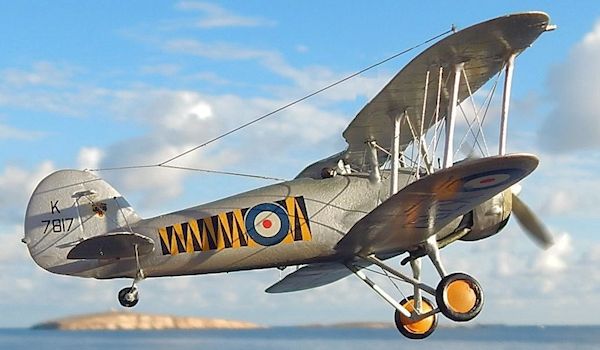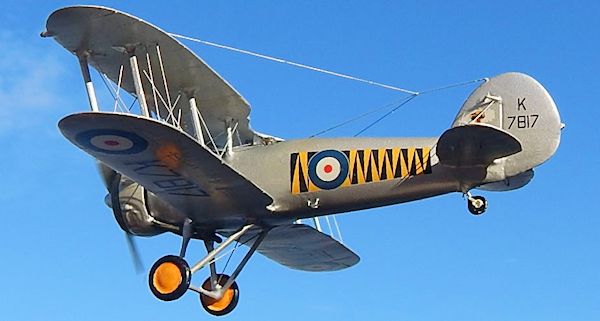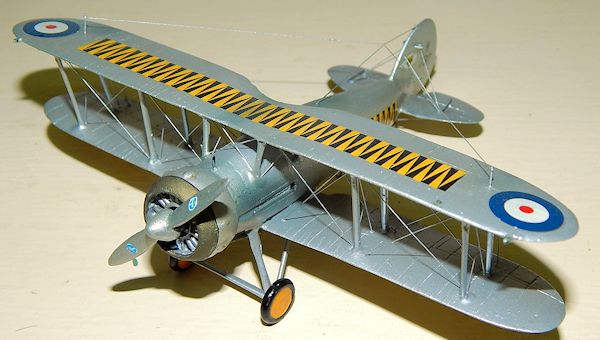
Airfix 1/72 Gauntlet II conversion
| KIT #: | ? |
| PRICE: | $ |
| DECALS: | One option |
| REVIEWER: | Carmel J. Attard |
| NOTES: | Conversion using Aeroclub parts and decals. |

| HISTORY |
When Hawker
Aircraft took over Gloster’s Works in 1934 studies were to integrate
production techniques and was then decided that Gloster should adopt Hawker
systems of construction. Air ministry placed a second production order for
104 Gauntlets in April 1935 with a further contract for 100 in September.
 employed
pairs of steel strips rolled to form flanged octagonal tubes and connected
together
with a steel strip web.
employed
pairs of steel strips rolled to form flanged octagonal tubes and connected
together
with a steel strip web.
In July the
next Gauntlet squadron was formed, this was No 66 Fighter squadron forming
at Duxford with a nucleus provided by No 19 Squadron commanded by
Sq.Ldr.Victor Croome. Working up on this unit continued smoothly throughout
the remainder of 1936. The following year a number of mishaps hit the
squadron, five of the aircraft being destroyed in mid-air collisions.
No 151 Squadron was another unit
reformed on August 4th 1936.
The squadron flew an assortment of replacement Gauntlets and seldom
possessed a strength of more than half a dozen aircraft, and did not receive
its full quota until March 1938.
Several other
squadrons received the Gauntlet and the last to receive them during 1937 was
No74 ‘Tiger’ squadron. These Gauntlets were conspicuous in co traversing
current Air Staff instructions by extending their famous black and yellow
“tiger’s teeth” markings to the tailplane leading edge thereby excluding or
re-positioning the serial number normally placed at the rear of fuselage
sides.
The Hornchurch
based 74 squadron received its Gauntlets after having discarded Gladiators
in June 1937, an anomaly that had never been explained authoritatively.
Among its pilots who won the Air Firing
 Challenge
Trophy in Gauntlets in 1938 was Flying Officer A.G. (Sailor) Malan.
Challenge
Trophy in Gauntlets in 1938 was Flying Officer A.G. (Sailor) Malan.
In 1937 no
less than 14 first-line RAF squadrons were equipped with Gauntlets but by
the end of that year Gladiators began to replace the older aircraft, while
monoplane fighters-Hurricanes- started to arrive at Northolt before
Christmas 1937. By May 1938 all Gauntlet 1s were gone from front line
squadrons in UK, and three-bladed metal Fairey propellers were introduced on
most Mk IIs. So unprepared for war Britain was at the time of Munich crisis
was shown by the fact that not one Gauntlet and Gladiator squadron was
available in combat readiness. All Gauntlet squadrons being on leave. Within
4 days all had been recalled, most of the aircraft being hurriedly and
inconsistently daub with various camouflage schemes. Some aircraft were
painted dark brown and green while others black overall in the role as
night-fighters.
| THE KIT |
Odd among my long
time ago bought models were that of the old Airfix Gladiator kit.
| CONSTRUCTION |
From
Aeroclub I got one 640HP Bristol Mercury VIS2 nine-cylinder air-cooled radial
engine driving a 2-blade wooden Watts propeller and also an engine cowling both
in white metal.
This I have picked from the long list of metal accessories this
cottage industry had on offer.
had on offer.
With a good set of scale plans I
scratch built a new undercarriage strut and exhaust pipe work. These were shaped
from Contrail struts and stretch sprue. Main planes were extended in accordance
to plans.
Fin and rudder and tail planes needed slight reshaping.
The cockpit area was altered from that of a closed type
to an open cockpit and reshaping and building around the cockpit to form the new
Gauntlet style of an open type. A windshield was shaped and cut from clear
acetate and fixed in place. The Gauntlet also called for additional struts to
each side owing to a bigger wingspan. The assembly followed the standard
sequence of assembling first the lower wings, adding the struts and slowly
positioning the upper wing span on top. Careful alignment of the wings looking
from front and side and these were all glued together and allowed to set
overnight. Some filler was needed at the extended wing pieces and also the wing
roots to fuselage. Final detail as cockpit climb step, wing tip lights and
cockpit interior was left for final stage. By now the kit was strong enough to
stand handling for applying string rigging in same way I did on previous
biplanes.
| COLORS & MARKINGS |
| CONCLUSIONS |
 I must
admit I enjoyed making this little kit modification if only for nostalgia of the
early RAF fighter aircraft from which the famous Gloster Gladiator has evolved.
It is not to be attempted by the raw beginner but should not deter anyone who
has made several kits and loves rigging too. As for flying the Gauntlet just
keep I mind that visibility in the air was very good but taxiing on the ground
it was necessary to weave on the ground to see ahead.
I must
admit I enjoyed making this little kit modification if only for nostalgia of the
early RAF fighter aircraft from which the famous Gloster Gladiator has evolved.
It is not to be attempted by the raw beginner but should not deter anyone who
has made several kits and loves rigging too. As for flying the Gauntlet just
keep I mind that visibility in the air was very good but taxiing on the ground
it was necessary to weave on the ground to see ahead.
October 2013
If you would like your product reviewed fairly and fairly quickly, please contact the editor or see other details in the Note to Contributors.